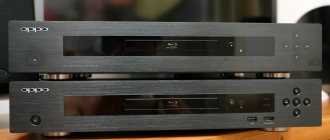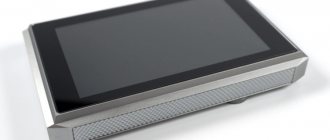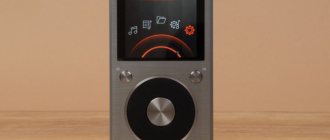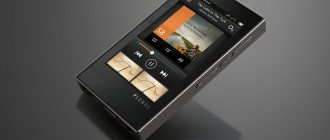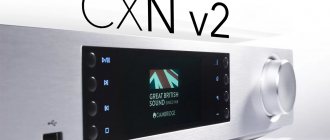Once upon a time there was a Korean company theBit, and it decided to make a player, and not just a simple one, but the most audiophile-quality one. They brought together well-known designers, electronics engineers and sound engineers in their country. The electronics engineers made a clever, multilayer board, the designers made an unusual and stylish case, and the sound engineers listened to the player and advised how to change the sound. And so it turned out to be a pocket player, created for the high-end, and the name was given to it OPUS#1.
Jokes aside, it is always interesting to look at products developed outside the “mainstream”, which, naturally, has been China for the last few years. That's why Opus Number One caught my attention. In fact, theBit is already developing a sequel to this model, which will differ in greatly improved parameters (and, I think, price), but when it will be released is still unclear, so for now we’ll figure out what you can actually buy.
The player is built on the Android OS, but, as in the case of the latest iBasso products, finding traces of it will be very problematic - a custom shell plus active removal of “extra” provide a convenient and simple interface, although they make it impossible to install third-party software. Also, the player did not include wireless interfaces (Wi-Fi is noisy, and Bluetooth is not for serious audiophiles). But they equipped it with a 4-core processor, a gigabyte of RAM and 32 gigabytes of internal memory. This is complemented by a screen with a resolution of 800 by 480. Two Cirrus Logic CS4398 and a fully balanced amplifier are responsible for the sound.
All this was rated quite respectably, the price of the device is about $550, but what is this Korean brick capable of?
Specifications
- Processor: 4-core ARM Cortex-A9 1.4 GHz
- RAM: 1 GB
- DAC: 2 × Cirrus Logic CS4398
- Frequency range: 20 Hz - 20 kHz (±0.02 dB), 10 Hz - 70 kHz (±0.3 dB)
- Signal-to-noise ratio (@ 1 kHz): 114 dB unbalanced, 115 dB balanced
- Channel Separation (@ 1 kHz): 130 dB unbalanced, 135 dB balanced
- Total harmonic distortion + noise: 0.0007% @ 1 kHz
- Output level: 2.1Vrms unbalanced, 2.3Vrms balanced
- Format support: WAV, FLAC, ALAC, AIFF, WMA, DSD, MP3, OGG, APE
- Maximum resolution: up to 192 kHz/24 bit
- Screen: 4″ TFT, 800 × 480
- Outputs: 3.5 mm TRS headphone/optical, 2.5 mm TRRS balanced
- Inputs: MicroUSB
- Built-in memory: 32 GB
- Memory cards: 2 × MicroSD up to 200 GB
- Battery: lithium polymer, 4000 mAh, 3.7V
- Operating time on one charge: ~ 10 h
- Charging time from 2A charger: ~ 4 h
- Dimensions: 72 mm × 112 mm × 18 mm
- Weight: 185 g
Portable music player The Bit OPUS#1
There are many victims on the conscience of smartphones. The extensive list of “eaten” includes portable video players, inexpensive compact photo and video cameras, car navigators... Although not killed, tablets, laptops and desktop computers were seriously damaged. Neither its former popularity nor the billions invested in development and promotion can save it. The only thing that allows you to stay afloat is the ability to do well what smartphones do not do well. For example, play music. And although budget MP3 players were among the first to be displaced, high-end portable music players are in steady demand, which is driving supply. Even in the problematic Russian market, new players are emerging. For example, the OPUS brand, owned by the Korean company The Bit. We start getting to know him with his debut model, OPUS#1.
The main advantage of smartphones - versatility - is also their Achilles heel. The radio frequency modules required for this type of technology (mobile communications, Wi-Fi, Bluetooth) are not only powerful sources of interference, but also voracious consumers of energy. It is no coincidence that some smart phones provide them with batteries of increased capacity. But you have to pay for this by increasing the size and weight of the devices, which has a detrimental effect on their portability. In addition, this type of equipment is under the strict dictates of fashion, and the trend towards constant reduction in the thickness of cases makes it difficult (if not impossible) to create portable equipment with decent sound.
The trend towards ever thinner cabinets makes it difficult (if not impossible) to create portable equipment with decent sound.
It is clear why smartphones equipped with balanced headphone outputs have not yet appeared - in thin cases there is simply no room for a double audio path. In a situation where some manufacturers are completely abandoning the only headphone jack, it is hardly worth hoping for the appearance of a second, balanced one. Therefore, specialized audio players with balanced outputs are out of competition.
Why does a portable device need a balanced output? Because it gives almost complete freedom in choosing headphones: a device equipped with it is capable of driving almost any phone - be it with high impedance or with low sensitivity. The compactness of the player itself does not mean that it should be used exclusively on the road and with portable headphones - you can listen to it at home with full-size ones. Provided that it is capable of providing decent sound quality. And if so, it can serve as an external USB DAC and even be integrated into stationary Hi-Fi systems as a source. And these are not abstract considerations, this is a trend that arose quite a long time ago and has already been embodied in many models from different brands. Here is the time to ask the question: what makes OPUS#1 stand out against their background? I answer: by following the idea of high-quality music reproduction, openly neglecting fashion. Putting technical feasibility above marketing prejudices and stereotypes. Now I’ll tell you how this manifests itself in the design.
The mathematics of success: subtract and multiply
The first impression does not bode well: the player comes in a box made of black matte cardboard with silver inscriptions - this is a kind of “uniform” for modern high-end models. The package is ascetic: the device itself, brief documentation, a protective film for the screen, a USB cable for charging and connecting to a computer. Something is missing? Cover? It can be purchased separately.
The front and rear panels are glossy - this is perhaps the only tribute to fashion. The side surfaces are matte and have beveled edges, making the case fit securely in the hand. It is difficult to determine its material by sight and touch, but the manufacturer does not hide the fact that it is ABS plastic. Here is the first manifestation of disdain for fashion: the mass public craves portable equipment in metal cases, but OPUS produces a far from cheap player in plastic. What do they allow themselves?! They allow themselves to use a material that is better than aluminum from all points of view. And cheaper than magnesium alloys, the use of which is only advisable in internal structural elements, and in this case it makes no sense at all. ABS plastic is durable, impact-resistant, elastic, and absorbs vibration well. And it can look very good, as we see in OPUS#1.
The compactness of the player itself does not mean that it should be used exclusively on the road and with portable headphones - you can listen to it at home with full-size ones.
Almost the entire front side is occupied by a touch screen, mechanical controls are located along the side edges. And since the body is asymmetrical and the number of buttons on each side is different, it is easy to operate the player blindly, say, when it is in your pocket. The playback control and volume control buttons are pressed with some effort, they are small in size and barely protrude above the body, so the likelihood of their false operation is minimal - this made it possible to abandon the key lock function, which often does more harm than good.
There are a minimum of connectors: USB for charging and communication with a computer, a 3.5 mm output for regular headphones (also linear), and a 2.5 mm balanced 4-pin output. They are switched through a “curtain”, which is pulled out from above with your finger. There is also a “thermometer” for screen brightness, buttons for turning on the equalizer, activating the sleep timer and playback order. At the top there is a time and date display, a battery indicator and a “gear” for accessing settings. And there in the “Output” section you can find a gain switch (low/medium/high). You will need to go to the USB item to select the connection mode to the computer (MTP or charging only) or activate the USB DAC function. In the latter case, you will need to install drivers on your Windows computer (you will need to download them from The Bit website).
Some manufacturers of portable players focus on digital processing, and not only in budget models, where DSP can partially compensate for the “curvature” of the path, the low quality of headphones and recordings with a high degree of compression, but also in the highest-class models, which in theory do not have there must be all these problems. OPUS is not involved in these games: the only digital processing is a 10-band equalizer, which may actually be needed, since headphones capable of providing a perfectly flat frequency response on any head do not exist in nature.
The processor does not amaze the imagination with either the number of cores or the frequency, but its power is more than enough for playing music: the interface works smoothly and without stuttering, and there are no problems with reading and sorting extensive music collections. By the way, about memory. The built-in storage capacity is 32 GB (many competitors are limited to 16 GB), there are also two slots for SDXC memory cards, and drives with FAT32, exFAT and NTFS file systems are supported.
The side surfaces are matte and have beveled edges, making the case fit securely in the hand.
The device runs Android OS, which can be seen from the “curtain” pulled out from above and from the setup menu, in which some “rudiments” remain: a keyboard selection section and an item for synchronizing time over the network - neither of which is here. However, OPUS#1’s “family ties” with smartphones are not as obvious as those of many competitors. The developers of the player resisted the temptation to cram wireless interfaces into it - they, of course, expand the capabilities of the device, but also create serious problems: as mentioned above, they consume battery energy, emit RF interference, which is not so easy to protect against due to dense installation and close proximity to sensitive analog circuits. At the same time, we saved money, not only on hardware, but also on licenses, which made it possible to redistribute the budget in favor of the audio path. In particular, it made it possible to make it truly balanced. And also install a precision reference oscillator and reduce the jitter level to 50 ps.
The digital-to-analog converter is based on two Cirrus Logic CS4398 chips. For a player in this price category, this is a unique solution: for example, the Astell&Kern company has a DAC on the same element base only with the AK120 II model ($1699), more affordable devices are content with one chip. I’ll note in passing that the CS4398 supports “direct” DSD playback (according to the documentation), but I have not yet seen a portable device on this chip that would implement this feature - usually one-bit streams are converted to PCM before being sent to the DAC. According to the information on the display, DSD signals are converted to PCM 192 kHz - in my opinion this is strange - conversion to 176 kHz would be more logical.
The manufacturer does not report the remaining circuit components (op-amps, etc.) used in OPUS#1. But by and large, we don’t really need this information - what’s more important to us is how the player plays, and we’ll find out that now.
Indoor and outdoor
The idea of using one player at home and on the road implies its compatibility with a wide variety of headphones - both in-ear and full-size surround. With different impedance, sensitivity and sound character. As my experience shows, the “right” amplifiers, even portable ones, are capable of maximizing the full potential of any headphones. That's why OPUS#1 testing involved two full-size models and two IEMs (both hybrid with dynamic and armature drivers).
The device completely “opened up” after 5-6 hours of operation - the stiffness went away, the top became more transparent, the feeling of some slowness and smoothed dynamics disappeared. Electronics usually come into condition faster, but portable ones may take longer.
ABS plastic is durable, impact-resistant, elastic, and absorbs vibration well. And it can look very good, as we see in OPUS#1.
I have listened to quite a few devices with Cirrus Logic CS4398 DACs, and I must say that they did not sound the same. The chip allows designers to choose the mode of operation of the digital filter, and if the developers preferred the linear phase option, the sound is cold, “analytical”, with “sparkles” - some people like it. Although in fact this is due to emissions that precede the sound impulse (the so-called pre-ringing), and is fraught with rapid fatigue, especially with headphones that do not have a significant roll-off at the highest frequencies. But OPUS#1 has the correct filter characteristic (minimal phase), which gives a more natural and pleasant sound.
With absolutely all the test headphones, the player still has a solid volume headroom. Even with the 300-ohm Sennheiser HD 650, the difference in level with other models is not as great as one might expect - the level has to be increased by 10 percent. It is this model that gives the most even, precisely balanced sound. Informative, detailed and at the same time extremely comfortable - you can listen for a very long time, even if you sit with headphones all day. Some “relaxation” characteristic of Audio-Technica ATH-W1000x phones in the lows does not appear with OPUS#1 - the bass is collected and clearly structured - the amplifier retains full control over the load. Whereas on smartphones with a standard audio path implemented on SOC, the bass loses intelligibility, becomes “wobbly” and monotonous. Another feature of these headphones is the very high resolution in the upper part of the range - all the “dirt” can be heard. But OPUS#1 shows itself very well here too: the smallest HF details are transmitted, but no coloration or audible distortion appears - everything is clean. This allows you to increase the volume and get larger, more sculpted sound images.
Inexpensive in-ear headphones do not play as “richly” and accurately as surround ones; their sound is harmonically simpler, but the difference is not so great as to spoil the mood. Urbanfun HiFi gives the best balance. But Xiaomi Mi PRO HD (the latest generation, with metal buttons on the remote control) needs an equalizer - you have to raise the lows by a couple of decibels and lower the highs by the same amount. But they have such a need with any amplifiers and players. Let me note in passing that the equalizer on OPUS#1 works correctly and does not introduce audible distortion - you can safely use it.
One of the important advantages of serious music players over smartphones is the correct playback of Hi-Res files. Formally, files with a bit depth of up to 24 bit/192 kHz and DSD can be reproduced by almost all modern smartphones, but we don’t know at what resolution the signal is supplied to the DAC. It happens that the bit depth is reduced to 16 bits, and the sampling frequency is reduced to 44.1 or 48 kHz depending on the reference frequency of the clock generator - this is the specificity of the Android sound subsystem (iOS does not have this problem, but there is another one - iTunes). In “audiophile” smartphones, this limitation is usually overcome by developers, although with some reservations. It happens that music players (usually budget ones) have forced oversampling, which inevitably affects the sound. In particular, the difference in sound between standard definition and Hi-Res material is leveled out - there is no point in keeping “heavy” files on the drive.
The only digital processing is a 10-band equalizer
With OPUS#1 you don’t even have to look at the parameters of the file being played (displayed on the right under the album cover) - you can determine whether the tracks are Hi-Res by ear. And not only in terms of how the tops are “cleaned” and become more informative, but in terms of increased credibility. Emotional involvement in the sound action increases. Yes, it just becomes more pleasant to listen to, you get more pleasure. But this is what we are willing to pay for, isn’t it?
The Bit Opus #1
Manufacturer: The BIT Col, Ltd (South Korea)
www.thebit.co.kr
Functions: music player, USB DAC || Display: TFT 4” (480 x 800) || Control: touch + mechanical buttons || Processor: 4-core ARM Cortex-A9 1.4 GHz || RAM: DDR3 1GB || Memory (built-in): 32 GB || Memory expansion capability: micro-SD cards x2 (Fat32, exFAT, NTFS) || Supported file formats: WAV, FLAC, ALAC, AIFF, WMA, DSD, MP3, OGG, APE || DAC Cirrus Logic CS4398 x2 || Supported resolutions: PCM up to 24 bit/192 kHz, DSD64/128 || DSD Playback: Converted to PCM || Equalizer: parametric 10 bands || Volume control resolution: 150 steps || Frequency range (±0.3 dB): 10 Hz - 70 kHz || Signal-to-noise ratio (single-ended/balanced), dB: 114/115 || THD + noise (@1 kHz): 0.0007% || Jitter: 50 ps || Output voltage (single-cycle/balanced, no load), V 2.1/2.3 || Output impedance (normal/balanced), Ohm: 2.0/1.0 || USB interface: Micro-B connector (charging and data transfer, MTP mode, for use as a DAC) || Outputs: analog headphone/line (3.5 mm), balanced (2.5 mm, 4-pin) || Power: Li-ON 3.7 V battery || Battery life: ~10 hours || Dimensions, mm: 72 x 112 x 18 || Weight, g: 160 || Price: 40,000 rub.
The digital-to-analog converter is based on two Cirrus Logic CS4398 chips. This is a unique solution for a player in this price category.
HEADPHONES
- Audio-Technica ATH-W1000x Grandioso (42 Ohm, 100 dB)
- Sennheiser HD 650 (300 Ohm, 103 dB)
- Fostex T50RP (50 Ohm, 98 dB)
- Xiaomi Mi PRO HD (32 Ohm, 98 dB)
- Urbanfun HiFi (20 Ohm, 106 dB)
MUSIC
- Deep Purple. "Machine Head" FLAC 96 kHz/24 bit
- Led Zeppelin. "II". FLAC 96 kHz/24 bit
- Bill Wyman. "Back To Basics" FLAC 44.1 kHz/16 bit
- The Gales Bros. "Left Hand Brand". FLAC 44.1 kHz/16 bit
- The Rolling Stones. “Blue & Lonesome.” FLAC 88.2 kHz/24 bit
- Catherine Russell. “Harlem On My Mind” FLAC 96 kHz/24 bit
- Anthony Wilson. "Power Of Nine" DSD64
- McIntosh Spectacular Reference Disc. FLAC 192 kHz/24 bit
- Larry Adler and Various. “The Glory of Gershwin.” FLAC 44.1 kHz/16 bit
- Snarky Puppy. “Culcha Vulcha.” FLAC 48 kHz/24 bit
- Livin' Blues. "Blue Breeze" FLAC 44.1 kHz/16 bit
share
Tags: Opus #1The Bit
Packaging and delivery
The box is completely in the spirit of recent traditions: black thick cardboard, an outer surface “like fabric”, a dust jacket made of black cardboard, silver embossing, everything is simple and functional. Inside, surrounded by pseudo-velvet, lies the player, and underneath is the delivery kit. With OPUS#1 you will get a screen protector, a MicroUSB lanyard and several different pieces of paper.
The case is not included in the package and is sold separately, this time it is very pretentious, it was made by Dignis themselves, and this can be seen in everything, from the very high quality leather to the unusual design.
Design and management
In terms of appearance, theBit also decided to take a non-standard route and use ABS plastic instead of the usual aluminum. In this regard, I have seen complaints on the Internet, but I don’t quite understand why high-quality plastic is so bad. The OPUS#1 case is well assembled, there are no cracks, backlashes, creaks or other defects. And the appearance, in my opinion, is quite good: the unusual asymmetrical shape, glass inserts on the front and rear panels give an unusual and memorable appearance. OPUS#1 uses a wider screen than other players, due to this it is closer to a square shape, again, subjectively, I like how the player fits in my hand.
Control elements are distributed on different sides of the device. On top there is a power and lock button, as well as two outputs - headphone and balanced. On the left side there are two volume buttons and a cover-covered slot for two memory cards. On the right side there are three playback control buttons, on the bottom there is a MicroUSB connector. By the way, the buttons would benefit from ergonomics if they were a little larger. The main part of the front panel is dedicated to the screen, it is quite good, although it still does not reach modern smartphones. Viewing angles are normal, readability remains poor in the sun, touches are processed quite clearly.
The interface was created almost from scratch and pleases with its simplicity and asceticism. In addition to the playback screen, the player has a section with a media library (standard browsing by folders, artists, genres, albums, favorites and all songs in a row). There is also a settings screen, short and complete. The short one allows you to turn on the equalizer, switch the balanced output mode and activate the sleep mode; it also adjusts the brightness of the screen. In the full version there is also a choice of language (Russian included), balance adjustment, equalizer tuning and other similar sections. Perhaps the only complaint about the firmware is the rather long scanning time for large memory cards, but at least it is less than that of the HiFiMan 901.
By the way, I would like to note that developers update the firmware very often; a new version was released literally on the day I started writing this review. There are no new features being added, but work is constantly being done on stability and bug fixes.
In general, on the one hand, the interface is simple and ascetic, on the other hand, it has almost everything you need, controlling the player is simple and you don’t have to waste time searching for any functions.
The Opus uses a very large battery, which allowed it to last 9 hours 40 minutes when playing FLAC with a resolution of 44.1 kHz/16 bits at a volume of 100 with MeeAudio P1 headphones. Depending on the file format, the time may vary in different directions. Charging the battery using the iPad's 2A power supply took 4 hours and 5 minutes. In general, good performance for a modern player.
Firmware
As in the previous version, the OS here is Android, however, unlike older models equipped with wireless modules and the ability to install third-party applications, the youngest OPUS is, as they say, “neither cold nor hot” from this fact. Google's operating system shows itself in almost nothing here, and the entire user interface is taken over by a custom software player.
Immediately after launching, the user is greeted by the playback screen, everything is familiar here: the album cover, track information and playback control buttons are displayed large. Tapping on the cover shows additional information and buttons for adding to favorites and playlists. The button with three bars in the upper left corner is responsible for going to the media library. Everything in the media library is familiar: browsing by folders, genres, albums, artists, favorites and playlists. The fonts are large, so navigation is very convenient.
On the main screen, as expected, there is a “curtain” of settings, which contains the main options of the player. There is also a button with a gear that opens a menu of additional settings. It almost completely duplicates that of any Android smartphone, with the exception of a few added items (sleep timer, gain switch, USB mode).
Since theBit players use a common code base, the firmware is very stable, is not picky in formats and has not been known for “bad behavior”.
Sound
The following headphones were used to listen to the device: ZMF Omni, Meze 99 Classics, Lear LHF-AE1d, Ambient Acoustics AM10, HiFiMan HE-400S, Audio Zenith PMx2, Noble Kaiser K10AU, Campfire Audio Jupiter, Dita Audio Brass.
The player's presentation is distinguished by somewhat unusual tuning; the developers seemed to be trying to make its sound as “comfortable” as possible, removing from it everything that could hurt the ear or interfere with listening. On the one hand, this leads to a feeling of unnaturalness in some familiar recordings, on the other hand, it makes the player’s sound convenient, comfortable and tolerant of headphones and the quality of the material. In general, the sound was not universal, but there are clearly connoisseurs of such a presentation.
The bass is deep enough, but the infrabass is a little lacking. The resolution is also good, the texture and separation of instruments in the low-frequency register are at a good level, but at the same time, the massiveness and impact of the bass is deliberately restrained so that the low frequencies do not pull the blanket over themselves. Simply put, the bass is good, but not for those genres that require a “wall of sound” and other mind-blowingly dense low frequencies.
The mids are a little smoother, the player removes the smallest nuances, although mostly recording flaws fall into this category, so on the vast majority of tracks this pays off, especially if you love music that is difficult to obtain in perfect mastering. On the other hand, the tracks retain the emotions and small details put into them intentionally. The player also increases the width of the imaginary stage; for example, this is beneficial for classical music, but some heavy metal bands begin to sound unusual. The depth of the virtual stage is also very good, but there are no surprises here; what is in the recording will be played back. The instruments convey their character well, although their sizes and positioning change slightly due to the "zoom in on the scene" effect.
The developers carefully relegated the upper frequencies to the background, I think again to achieve a comfortable sound. Fortunately, this was done moderately and without any attempt at smoothing; the high frequencies are simply reduced quantitatively, but at the same time they are well developed and delight with detail and nuances.
Traditionally, several comparisons with players of a similar price category.
Cayin N6. The older model Cayin offers a slightly warmer presentation with an emphasis on musicality and cohesive presentation. The imaginary stage N6 builds smaller in both directions.
QLS 360. The QLS brick is closer to what is commonly considered “monitor quality”, it conveys more micro-details and does not try to change anything in the presentation, but sometimes it sounds rougher, although this depends more on the recordings and personal preferences.
Fiio X7 + AM2. The Fiio player with a second amplification module delivers sound more smoothly, while maintaining a small amount of warmth. In general, it sounds more emotional, but without overkill, like, for example, the QLS.
Comfort and details
I listened to the player in tandem with the ADL H128 - fairly neutral, honest and melodic headphones, which were enough for 70-90 volume points out of the available 150. And Opus #1 worked great with them.
The player's sound itself is a little melodious and at the same time slightly smoothed. On the one hand, it sounds detailed, on the other hand, it hides roughness, especially in the mid-frequency range. As a result, the sound is natural, not bright, and with nuances.
The player’s screen, of course, is far from modern smartphones, but it’s enough for everyday tasks even on a sunny day
The player's bass is not aggressive, I would even say relaxed, but not slack. Classic rock like Deep Purple, Eagles and Pink Floyd did not suffer from such bass, nor did the slightly funky “Get Lucky” from Daft Punk. And even in front of Kanye West, the player did not give up in the low-frequency aspect, although it was still slightly lacking in rigidity. The esoteric “Bari Improv” performed by Kaki King lost a little of its esotericism and depth due to the smoothed punch of the guitar. The bass, apparently, is deliberately restrained just in order to achieve that very comfortable sound.
The mids seem slightly polished, but still retain emotion and detail. Dirt and noise disappear somewhere, and melodic nuances appear in their place. This has translated well into EDM sounds like Nitro Fun or synthpop in the form of the new album Ulver. The player also treats voices sparingly, not putting them in the foreground, but not pushing them into the background - they feel like a separate instrument, which, like the others, is assembled into a single picture.
The same effect is present at high frequencies: they seem to be slightly pushed back and slightly softened, but at the same time they do not lose nuances and comfort. The player's stage seems wide and voluminous, the instruments are distinguishable, but due to this imaginary width they feel a little unusual. As a result, Opus #1 sounds unusual - seemingly detailed, but unobtrusive. These details are not exposed, but are intelligently and neatly integrated into the overall outline of the sound, which is why you can listen to the player for a long time and not get tired at all.
Unfortunately, I was not able to evaluate the performance of the balanced input, but judging by the reviews of foreign colleagues, with it the player sounds more open and dynamic.
Compatibility
One of the distinctive features of the player is its fairly stable operation under any load, from sensitive IEMs to fairly tight full-size ones. Of course, it’s not particularly logical to listen to top isodynamic or 300-ohm models on it, but it rocks most “large” headphones properly. There is some noise, but it is only audible in the most sensitive low impedance models.
Genre-wise, I would recommend the player more for calm and complex styles such as classical, vocal and instrumental music, but I also listened to rock/metal with it. OPUS is tolerant of the quality of recordings; on a 10-point scale, I would rate it a 5.
And according to tradition, several tracks for example
DeadLock - Darkness Divine. Upbeat and energetic metal is always a good test for a player. Not all devices can avoid turning it into a dull lullaby, smoothing out all emotions, but at the same time not burning out the listener’s brain with harshness and bright sound. And although OPUS#1 is closer to the first alternative, it retains enough drive to please fans of “meat” and aggressive riffs.
Camel - Dunkirk. In my humble opinion, The Snow Goose is one of the greatest albums in the history of art/prog rock. Of course, there were many outstanding works by the pillars of the genre from Genesis to Yes, but few could tell the whole story just like that, simply and without words. The wide stage that the hero of today’s review is building fits perfectly into this multifaceted polyphonic canvas.
Exxasens - Polaris. And some of the best instrumentalists of our time, traditionally belonging to the post-rock genre, despite the fact that they are cramped within this framework. The complex sound canvases of this group are like an ocean wave - as they roll, they knock you off your feet and carry you along with you. OPUS#1 very interestingly lays out this track in depth, allowing you to hear individual parts behind the general sound wall and enjoy their complexity.
